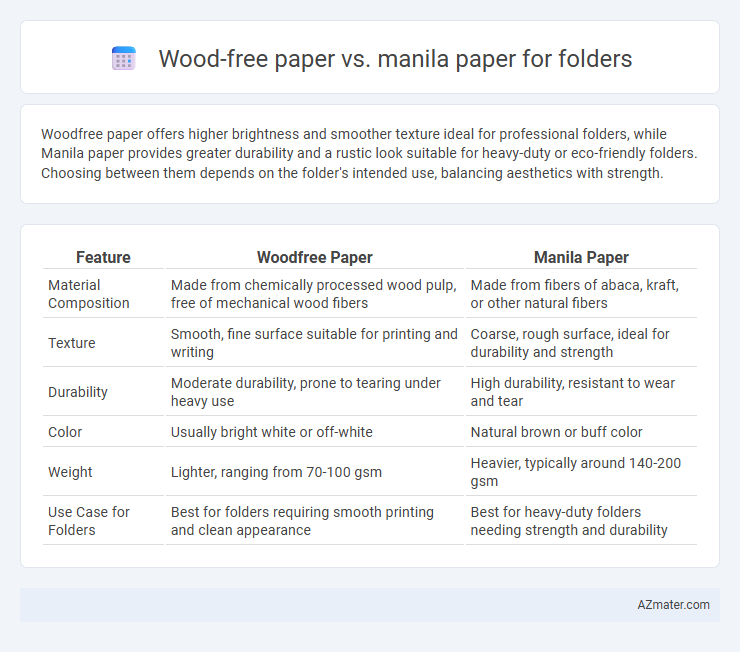Woodfree paper offers higher brightness and smoother texture ideal for professional folders, while Manila paper provides greater durability and a rustic look suitable for heavy-duty or eco-friendly folders. Choosing between them depends on the folder's intended use, balancing aesthetics with strength.
Table of Comparison
| Feature | Woodfree Paper | Manila Paper |
|---|---|---|
| Material Composition | Made from chemically processed wood pulp, free of mechanical wood fibers | Made from fibers of abaca, kraft, or other natural fibers |
| Texture | Smooth, fine surface suitable for printing and writing | Coarse, rough surface, ideal for durability and strength |
| Durability | Moderate durability, prone to tearing under heavy use | High durability, resistant to wear and tear |
| Color | Usually bright white or off-white | Natural brown or buff color |
| Weight | Lighter, ranging from 70-100 gsm | Heavier, typically around 140-200 gsm |
| Use Case for Folders | Best for folders requiring smooth printing and clean appearance | Best for heavy-duty folders needing strength and durability |
Introduction to Folder Paper Types
Woodfree paper, characterized by its smooth surface and high brightness, is ideal for folders requiring a professional finish and durability, often used in office settings for presentations and important documents. Manila paper, made from unbleached pulp with a natural beige color, offers greater strength and cost-effectiveness, commonly chosen for everyday use and heavy-duty folders that need to withstand rough handling. Understanding these folder paper types helps in selecting the right material based on the folder's purpose, balancing aesthetics, durability, and budget.
What is Woodfree Paper?
Woodfree paper is a high-quality, chemical pulp paper known for its smooth surface, brightness, and durability, making it ideal for professional documents and folders. Unlike manila paper, which is made from untreated fibers and has a coarse texture and natural brown color, woodfree paper undergoes a chemical pulping process that removes lignin, preventing yellowing and improving resistance to aging. This results in a cleaner, more polished appearance suitable for folders requiring a refined finish.
What is Manila Paper?
Manila paper is a type of strong, durable paper made from manila hemp fibers, known for its natural tan color and resistance to tearing, making it ideal for folders and packaging. Unlike woodfree paper, which is chemically processed and bleached for a smooth, white finish, manila paper maintains a coarse texture and higher strength due to its unbleached fibers. This durability and distinctive appearance make manila paper a preferred choice for folders requiring sturdiness and a traditional look.
Physical Properties Comparison
Woodfree paper, made from chemical pulp with minimal lignin, offers superior smoothness, brightness, and uniformity, making it ideal for high-quality print folders. Manila paper, derived from abaca fibers, exhibits greater durability, higher tear resistance, and a coarser texture, providing robust strength suited for heavy-duty folders. The choice between woodfree and manila paper depends on the balance needed between print quality and physical toughness for folder applications.
Durability and Strength Analysis
Woodfree paper, primarily made from chemical pulp, offers a smooth surface with moderate durability, making it suitable for folders that require clean printing and a professional appearance. Manila paper, composed of mechanical pulp with longer fibers, provides superior durability and strength, resisting tears and heavy usage typical for frequent handling and storage. For folders needing long-term durability and robust strength, manila paper outperforms woodfree paper due to its fiber composition and resistance to wear and tear.
Print Quality: Woodfree vs Manila
Woodfree paper offers superior print quality for folders due to its smooth, bright surface, which enhances ink absorption and color vibrancy, delivering sharp and clear prints. In contrast, Manila paper has a rougher texture and natural tan color, which can cause prints to appear duller and less precise, making it less ideal for high-resolution images or detailed graphics. Choosing woodfree paper ensures folders with professional, crisp, and vivid printed text or images.
Environmental Impact Considerations
Woodfree paper, made from chemical pulp, has a lower lignin content, resulting in higher recyclability and less environmental pollution during production compared to Manila paper, which is made from abaca fibers requiring more energy-intensive processing. Manila paper, while durable and biodegradable, involves harvesting natural fibers that can contribute to deforestation and habitat disruption if not sourced sustainably. Choosing woodfree paper for folders supports eco-friendly practices through reduced chemical use and better waste management, whereas Manila paper's environmental impact varies significantly depending on the sourcing and manufacturing processes.
Cost and Availability Comparison
Woodfree paper for folders typically offers lower cost and broader availability due to mass production and widespread industrial use, making it a budget-friendly option for large-scale projects. Manila paper, often manufactured from natural fibers, tends to be more expensive and less readily available as it caters to niche uses like craft and specialty folders. Businesses seeking economical and easily sourced folder materials usually prefer woodfree paper over manila for cost efficiency and supply consistency.
Best Use Cases for Each Paper
Woodfree paper, made from chemical pulp and free from mechanical pulp, offers a smooth, high-quality surface ideal for professional folder printing where crisp graphics and sharp text are essential. Manila paper, recognized for its durability and coarse texture, is best suited for folders requiring resilience and everyday handling, making it popular in school or office settings for organizing documents. Choosing woodfree paper enhances aesthetic appeal in presentations and marketing materials, while manila paper excels in practical applications demanding sturdiness and cost-effectiveness.
Conclusion: Choosing the Right Paper for Folders
Woodfree paper offers smooth texture and superior print quality, making it ideal for professional folders requiring sharp graphics and durability. Manila paper provides a cost-effective, sturdy option with a distinct natural look, suitable for folders intended for everyday use or temporary storage. Selecting the right paper depends on balancing budget, desired appearance, and folder functionality for effective document protection and presentation.

Infographic: Woodfree paper vs Manila paper for Folder
 azmater.com
azmater.com